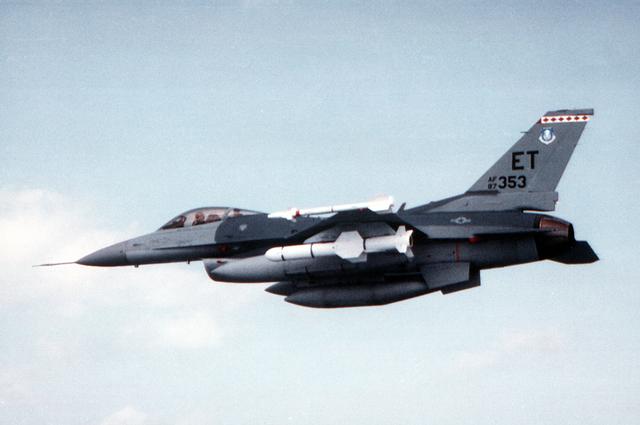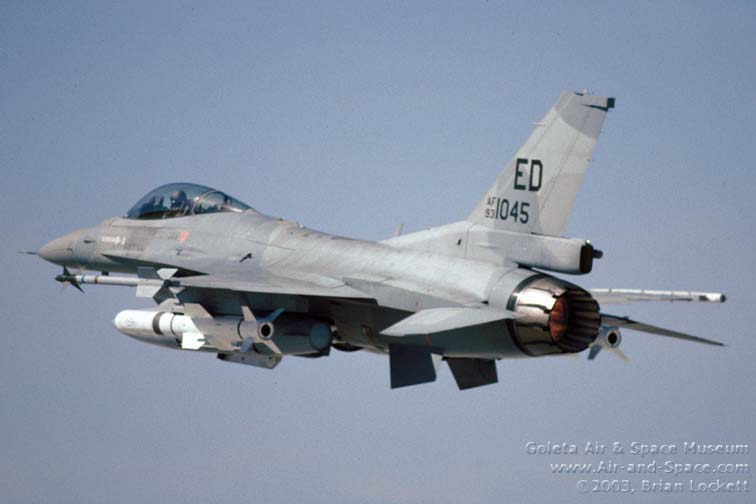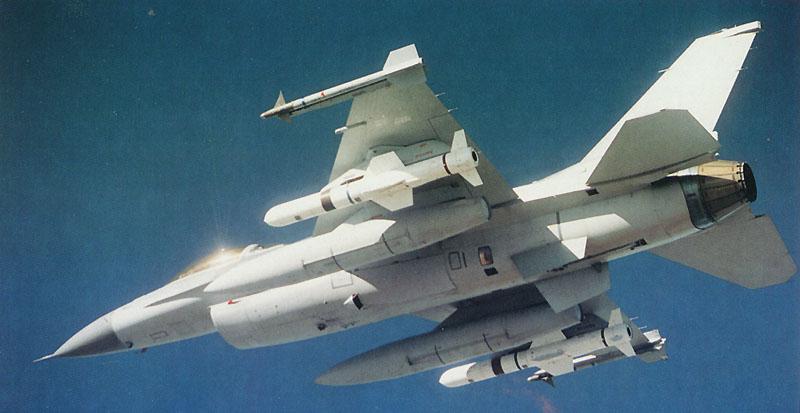 |
AGM-84 HarpoonAnti-ship missile |
Introduction
The AGM-84 Harpoon is an all weather, over-the-horizon, anti-shipping missile system produced by McDonnell Douglas (now Boeing). Its low-level, sea-skimming cruise capability, active radar guidance and warhead design assure high survivability and effectiveness. The missile is capable of being launched from aircraft, surface ships, submarines, and shore batteries.
The Harpoon/F-16 combination is used as an anti-shipping platform by a limited number of international F-16 customers.
History
After the sinking of the Israeli destroyer Eilat in 1967 by Soviet-built anti-ship missiles, the U.S. Navy saw the need to develop a dedicated anti-shipping missile. The name Harpoon was assigned to the project, as in a harpoon to kill "whales", a naval slang term for submarines, even though Harpoon's primary mission became surface ship attack.
The development project formally begun in 1968, and the missile was designated ZAGM-84A in 1970. The Navy issued a formal RfP (Request For Proposals), and in June of 1971 McDonnell-Douglas was awarded the prime contract for Harpoon. The first test missile flew in October of 1972.
The A/R/UGM-84 was first introduced in 1977, and in 1979 the air-launched version was first deployed on the Navy's P-3C Orion aircraft. The Harpoon was also adapted for use on B-52H and F-16 aircraft, and is currently being integrated on the F-15 (the USAF only uses Harpoon on its B-52H bombers, the F-16/F-15 integration is for non-US customers). The Harpoon missile can also be launched from submarines.Under a 1998 agreement between Boeing and the Navy, an advanced upgrade to Harpoon missile was developed. This Harpoon Block II missile incorporated Global Positioning System [GPS] assisted inertial navigation, which gives the system both an anti-ship and a land attack capability.
Construction
The guidance section consists of an active radar seeker and radome, Missile Guidance Unit (MGU), radar altimeter and antennas, and a power converter. The MGU consists of a three-axis attitude reference assembly (ARA) and a digital computer/power supply (DC/PS). Prior to launch, the DC/PS is initialized with data by the Command Launch System. After launch, the DC/PS uses the missile acceleration data from the ARA and altitude data from the radar altimeter to maintain the missile on the programmed flight profile. After seeker target acquisition, the DC/PS uses seeker data to guide the missile to the target.
The warhead section consists of a target-penetrating, load-carrying steel structure, containing 215 pounds of high explosive (DESTEX) and a safe-and-arm/contact fuze assembly. The safe-and-arm/contact fuze assembly ensures the warhead will not explode until after the missile is launched. It is designed to explode the warhead after impacting the target. The warhead section can be replaced by an exercise section, which transmits missile performance data for collection and analysis.
The sustainer section consists of a fuel tank with JP-10 fuel, an air inlet duct and a jet engine. This provides the thrust to power the missile during sustained flight. The sustainer section has four fixed fins, which provide lift.
The control section consists of four electromechanical actuators which use signals from the guidance section to turn four fins, which control missile motion.
The booster secion consists of a solid fuel rocket and arming and firing device. Surface and submarine platforms use a booster to launch Harpoon and propel it to a speed at which sustained flight can be achieved. The booster section separates from the missile before sustained flight begins.
Versions
AGM-84A, RGM-84A, UGM-84A


The ENCAP consists of a nose cap, main body and after body. The missile is on shock isolator rails within the main body. The after body has fins, which direct the ENCAP towards the surface at the proper angle for missile launch. Once the ENCAP breaches the surface, a small rocket blows off the nose cap and the missile is launched out of the tube.
AGM-84B, RGM-84B, UGM-84B
The UGM-84B is a standard UGM-84A which was build for use with the Royal Navy. The only difference between the two missiles is that the B-versions has a slightly lower cruising altitude. Although the AGM-84B and RGM-84B designations were allocated, no such missiles were ever build.
AGM-84C, RGM-84C, UGM-84C (Block 1B)
This versions was first introduced with the USNavy in 1982. It retained the lower cruising altitude of the B-version and added a sea-skimming flight profile, not popping up before impact. This made it more difficult to detect the missile.
AGM-84D, RGM-84D, UGM-84D (Block 1C)
The AGM-84D was first introduced in 1985. It features an increased range of 220 km (120 nm) and it uses JP-10 fuel instead of JP-6 fuel as its predessecors did. Learning from the experience with the older models, the terminal attack mode was made selectable to include a pop-up or sea-skimming profile. On top of that the missile provided the possibility that ships who are equipped with the AN/SWG-1A Fire Control System can program several way-points into the flight path of the missile before launch so that the missile will fly an indirect path to the target area and thus concealing the position of the launching ship.AGM-84E, RGM-84E (Block 1E) / SLAM [Stand-Off Land Attack Missile]

The AGM-84E uses an inertial navigation system with GPS, infrared terminal guidance, and is fitted with a Tomahawk warhead for better penetration. SLAM can be launched from land-based or aircraft carrier-based F/A-18 Hornet aircraft. It was employed successfully in Operation Desert Storm and UN relief operations in Bosnia prior to Operation Joint Endeavor.
The projected ship launched RGM-84E was tested but never passed this stage of development.
AGM-84F, RGM-84F (Block 1D)
The Block 1D version that featured a larger fuel tank and reattack capability was developed in 1991. With the reduced threat because of the break-up of the Soviet Union, this upgrade was shelved in 1993 and never produced.
AGM-84G, RGM-84G, UGM-84G (Block 1G)
The AGM-84G, RGM-84G and UGM-84G versions of the Harpoon missile are upgraded D-model (Block 1C) missiles. They feature the reattack capability of the F-model (Block 1D) missiles (which was cancelled). It also features improved ECCM capabilities. The G-model missiles will be acquired by re-building older D-model missiles.
AGM-84H (Block 1F) / SLAM-ER (Expanded Response)
The SLAM-ER (Expanded Response) is a major upgrade to the SLAM missile that is currently in production. It provides over twice the missile range, target penetration capability and control range of SLAM. The SLAM-ER has a greater range (150+ miles), a titanium warhead for increased penetration, and software improvements, which allow the pilot to retarget the impact point of the missile during the terminal phase of attack (about the last five miles). In addition, many expansions are being made to improve performance, survivability, mission planning, and pilot (man-in-the-loop) interface.
The SLAM-ER development contract was awarded to McDonnell Douglas Aerospace (Now Boeing) in February of 1995. SLAM-ER achieved its first flight in March of 1997. All Navy SLAM missiles will be retrofitted to SLAM-ER configuration. About 500 SLAM missiles will be converted to the SLAM-ER configuration between FY 1997 and FY 2001.
RGM-84J
This designation was allocated to the "Harpoon 2000" improvement, which later evolved into the Block 2. No development order was placed and so the project was cancelled.
AGM-84K (Block 1F)
This versions is an improvement over the earlier AGM-84H. Existing H-models will be converted to this new SLAM-ER standard.
AGM-84H / SLAM-ER ATA (Automatic Target Acquisition)
The SLAM-ATA (Automatic Target Acquisition) is a follow-on enhancement to the SLAM-ER with reattack capability and a new seeker. It was fielded in 2002. SLAM-ERs equipped with ATA will match the seeker images of a target scene with an on-board reference image. This process will improve the missile's ability to strike targets in cluttered spaces, such as urban areas. It will also improve missile-targeting capability in poor weather, counter measure protected environments, and better enable offset aimpoint targeting. Older H and K-model missiles will be upgraded with this new functionality over the coming years.
AGM-84L, RGM-84L (Block 2)
The Block 2 is an upgrade program to improve the baseline capabilities to attack targets in congested environments. The upgrade is based on the current Harpoon specifications. The Block 2 will provide accurate long-range guidance for coastal, littoral and blue water shipping targets by incorporating the low cost integrated Global Positioning System/Inertial Navigation System (GPS/INS) from the Joint Direct Attack Munitions (JDAM) program currently under development by Boeing.
GPS antennae and software from Boeing's Standoff Land Attack Missile (SLAM) and SLAM Expanded Response (SLAM ER) will be integrated into the guidance section. The improved littoral capabilities will enable Harpoon Block 2 to impact a designated GPS target point. The existing 500-pound blast warhead will deliver lethal firepower against land and sea based targets.
For the anti-ship mission, the GPS/INS provides improved missile guidance to the target area. The accurate navigation solution allows target ship discrimination from a nearby landmass using shoreline data provided by the launch platform. These Block 2 improvements will maintain Harpoon's high hit probability while offering a 90% improvement in the separation distance between the hostile threat and local shorelines. Harpoon Block 2 will be capable of deployment from all platforms, which currently have the Harpoon Missile system by using existing command and launch equipment.
F-16 Installation
Integration of the AGM-84 with the F-16 required two main changes: (i) addition of Harpoon-specific weapon control algorithms to the Stores Management System, and (ii) development of an interface adapter kit. The interface adaptor is basically an electronic component that converts weapons control instructions from the F-16 Stores Management System into instructions that can be interpreted by the weapon (Harpoon in this case).
The work started during Operation Desert Storm on Korea-based USAF Block 30G aircraft. Two factors complicated the actual development of the interface adaptor and algorithms. First of all, the "heavy stations" (hardpoints 3 and 7, capable of carrying a heavy weapon such as the Harpoon) did not offer access to the 1553 data bus. Second, there were some initial software problems with the jet as well. To circumvent the limitations, the AGM-65 Maverick interface was re-used initially. The Maverick interface did not require the F-16 SMS to do anything extra, as all control software was in the adapter kit. Weapon modes and targeting were all selected on the video provided in lieu of the normal Maverick video.
As the Storm wound down, USAF lost interest and the initial effort was cancelled. The project was picked up again later when foreign F-16 customers expressed interest in the Harpoon. By that time, the software problems had been solved and the Harpoon was properly integrated. The AGM-84 Harpoon was officially cleared on the F-16 on August 11th, 1994.
All recent F-16 aircraft (block 20, 30/32, 40/42, 50/52, and 60) can be made Harpoon-capable. It requires the installation of the interface adapter, plus installation of system software that supports the Harpoon.
F-16 Loadout
Stations 3 and 7 can be wired to carry a single AGM-84.
 |
 |
Operational Use
Only a limited number of F-16 customers use the Harpoon on their F-16s:
- Chile: The FACh's block 52 aircraft have Harpoon capability, but no missiles have been ordered
- Egypt: EAF Block 40 aircraft have Harpoon capability, no missile purchase yet
- Greece: HAF F-16 Block 52 aircraft armed with AGM-84 Harpoons were test-flown at Edwards AFB
- Israel: The IDF/AF is very likely to have Harpoon capability, but this is unconfirmed
- Oman: The RAFO purchased 20 missiles for its F-16 Block 50 fleet
- South Korea: The RoKAF Block 52 aircraft are Harpoon-capable, no confirmed missile purchase
- Taiwan: The RoCAF purchased 54 missiles for its F-16 Block 20 aircraft
- Turkey: The TUAF purchased 50 Harpoon missiles for their CCIP-upgraded F-16 Block 50 aircraft
- United Arab Emirates: The UAEAF's block 60 aircraft are Harpoon capable, and 52 missiles were purchased at the time of the Block 60 deal
- USA: Although the USAF was briefly interested in using the Harpoon on their F-16s during Operation Desert Storm and started the integration work, they lost interest when Desert Storm wound down. Not an operational customer.
Specifications
Primary Function: Anti-ship missileContractor: Naval Weapons Center
Power Plant: Sustainer: Teledyne/CAE J402-CA-400 turbojet; 3.0 kN (680 lb);
Booster (RGM/UGM-84 only): A/B44G-2 or -3 solid-fueled rocket; 53 kN (12000 lb) for 2.9 sec
Length: see table below
Launch Weight: see table below
Diameter: 13,5 inches (34,3cm)
Wingspan: see table below
Range: see table below
Speed: Mach 0.85
Warhead: see table below, Blast fragmentation
Unit Cost: $527,000 (FY 1999)
| Harpoon | Length (mm) | Span (mm) | Launch Weight (kg) | Range (km) | Warhead (kg) |
|---|---|---|---|---|---|
| AGM-84A | 3850 | 914 | 540 | 220 | 221 |
| AGM-84B | 3850 | 914 | 540 | 220 | 221 |
| AGM-84C | 3850 | 914 | 540 | 220 | 221 |
| AGM-84D | 3850 | 914 | 540 | 220 | 221 |
| AGM-84E | 4500 | 914 | 627 | 93 | 221 |
| AGM-84F | 4440 | 914 | 635 | 315 | 221 |
| AGM-84G | 3850 | 914 | 540 | 93 | 221 |
| AGM-84H | 4370 | 2430 | 725 | 280 | 360 |
| AGM-84J | 3850 | 914 | 540 | 93 | 221 |
| AGM-84K | 4370 | 2430 | 725 | 280 | 360 |
| AGM-84L | 4370 | 2430 | 725 | 280 | 360 |
Special thanks
- Loader
- Gums
- KarimAbdoun
Sources
- Fas.org on AGM-84: http://www.fas.org/man/dod-101/sys/smart/agm-84.htm
- Ausairpower: http://www.ausairpower.net/TE-Harpoon.html
Please use this form to add any list any error or omissions you find in the above text.
Note: your comments will be displayed immediately on this page. If you wish to send a private comment to the webmasters, please use the Contact Us link.



